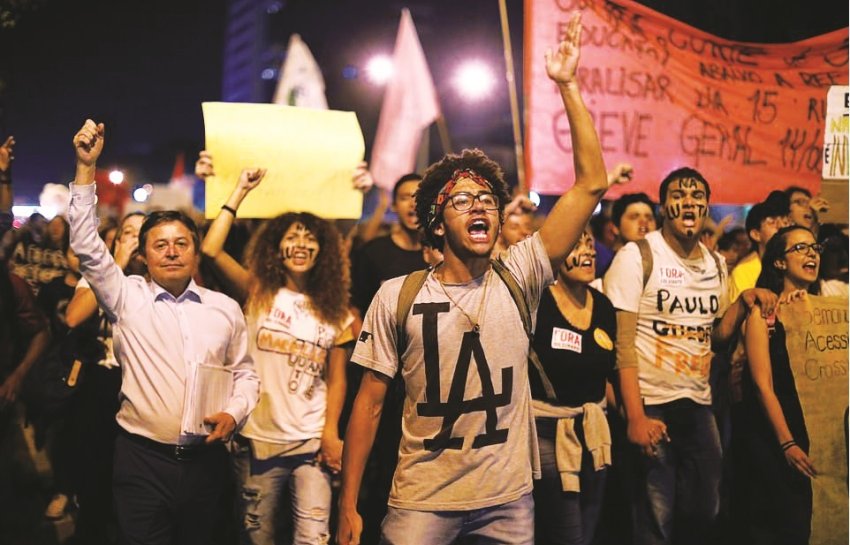
A nationwide education strike on May 15 became the platform for the biggest anti-government protests since President Jair Bolsonaro took power.
More than 1 million people demonstrated, some estimating up to 2 million. Protests brought together unions, academics, teachers, students, campaign groups, political parties and other diverse factions — the birth of a movement, and the strongest display of left unity in Brazil in decades, on a scale that took many by surprise.
This is a battle for the country’s future: it is the beginning of the fightback against Bolsonaro’s war on education — a needless wave of ideological vandalism, where an imagined internal enemy of “marxist indoctrinators” are persecuted and used as justification for cutting the public education system and for a 30% cut to public university funding.
Under the Luiz Inácio Lula da Silva and Dilma Rousseff Workers’ Party governments, universities underwent massive expansion. There was a revolution of inclusion, with many working class and Afro-Brazilian students gaining access to higher education for the first time in the country’s history.
Economics minister Paulo Guedes plans a privatised system from which those connected to him stand to profit, and school closures in favour of distance learning.
Philosophy and sociology courses are to be shelved, as took place at the height of the 1964–85 military dictatorship, and thousands of scholarships have already been cut. Research budgets have been slashed and entire departments closed, causing a brain-drain of Brazilian scientists to foreign shores — an attack on the country’s development, on the future itself.
The May 15 demonstrations combined demands around education funding with defence of workers’ rights, and against neoliberal pension cuts — coveted by foreign interests such as NATO think tank the Atlantic Council.
The protests encompassed elements of the 2018 “Ele não” (Not him) anti-Bolsonaro protests, and widespread demands to free political prisoner and former president Lula, who would now almost certainly be Brazil’s head of state had he not been jailed by Bolsonaro’s justice minister.
About 300,000 people congregated on Avenida Paulista in São Paulo, filling the area from Rua Augusta to Pamplona. The tightly-packed crowds marched to the São Paulo State Assembly. Rio had similar numbers, filling Avenida Presidente Vargas before being dispersed by military police using tear gas and flash bombs. Massive numbers were out in Belo Horizonte, and demonstrations were held in all state capitals, and in the capital Brasília. In total, protests took place in about 200 municipalities.
A major difference between this, previous general strikes and mobilised resistance to the 2016 coup, was that mainstream television broadcaster TV Globo covered it.
As many observed, it did have a certain sensation of the mass protests that shook the country in June 2013 — but this time everyone present knew exactly why they were there. In 2013, many people took to the streets with confused and contradictory messages. There was no such ambiguity or incoherence this time.
Another difference from June 2013 was the response of the president. Back then, former president Rousseff called the mass demonstrations a “display of democracy”, and reminded us that her own movement had come from the streets.
She reiterated her plan for a revolution in public education, using the proceeds from Brazil’s newfound oil wealth, and also proposed an initiative for constitutional reform.
Bolsonaro instead stoked further anger by calling the May 15 protesters “idiots” and “imbeciles”.
Bolsonaro’s new education minister, Abraham Weintraub, continues to blame the Rousseff government for cuts made after the coup to remove her — a coup that he and his allies all supported.
Their economic policy is a continuation of the Michel Temer administration’s austerity, including the notorious “end of the world amendment”, an unprecedented 20-year constitutionally protected freeze on health and education investment.
That policy and the current cuts are based on the 2016 coup myth that Brazil was “broke” or even “bankrupted” under Rousseff. In reality, it had R$1 trillion in liquidity, made up of US dollar reserves, US bonds and other sources. This was built up after repaying the International Monetary Fund, World Bank and Paris Club, and was intended to insulate against economic shocks, making austerity cuts unnecessary. In Brazil, as in other countries, austerity is a choice and rooted in ideology, not economic necessity.
Many insist that education is not ideological, but the discourse has shifted so far rightward that only the Brazilian left is fighting for public education.
Brazil has now had two successive governments that failed to grasp the basic concept that education funding is an investment, not an overhead.
There were early attempts to coopt the movement — from at home and abroad — by interests that supported both the process that brought Bolsonaro to power and the extreme neoliberal economic policy his government is pursuing.
Those on the streets are unlikely to get fooled again.
May 15 felt like perhaps the ghosts of June 2013’s “stolen movement” had been finally laid to rest.
Another day of mass protest is scheduled for May 30.
[Abridged from Brasilwire.]